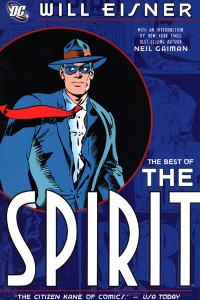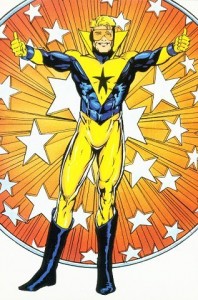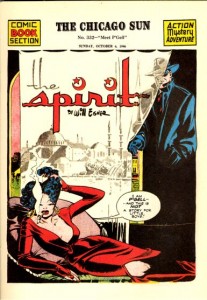The Return of the Superhero Originality Game
 A recent strip from Let’s Be Friends Again by Chris Haley and Curt Franklin perfectly sums up how I feel about Marvel and DC Comics. Basically, I think that the two major purveyors of sequential art are in a creative malaise largely of their own making.
A recent strip from Let’s Be Friends Again by Chris Haley and Curt Franklin perfectly sums up how I feel about Marvel and DC Comics. Basically, I think that the two major purveyors of sequential art are in a creative malaise largely of their own making.
A few weeks ago, I wrote about an exercise - the Superhero Originality Game – that highlights that stagnation. The rules are explained at length in my previous post but, in short, the idea is to try and think of completely original characters that were created in the past thirty years that could (or have) carried their own monthly titles for Marvel or DC Comics.
I had gotten the ball rolling with a list of 10 characters who met the criteria:
1.Booster Gold
2.The Sentry
3.Wild Dog
4.Speedball
5.Elektra
6.Venom (Eddie Brock or Angelo Fortunato but not Mac Gargan)
7.Amanda Waller
8.Terror Inc.
9.Deathstroke
10.Deadpool
I had invited my readers to try and add to the list, and they came up with an additional 14 characters:
11. Rage
12. Night Thrasher (Dwayne Taylor, not his brother Donyell Taylor, aka Bandit)
13. Amadeus Cho
14. War Machine
15. Zauriel
16. Shatterstar
17. Magog
18. Beta Ray Bill
19. Lobo
20. Cloak and Dagger *
21. Cyborg
22. Raven
23. Starfire
24. Silver Sable
The point of the game was to try and highlight the fact that, to a large extent, the Big Two comic book publishers have produced less than one new marketable character per year. It’s not just that they’re no longer creating new series, there aren’t many original characters being created, period.
Instead, comic book fans are being treated to Spider-Man fighting the Vulture. Again. Or another Teen Titan dying. Rehashing and re-telling seems to be the name of the game.
It’s a disappointing trend.
Imagine if two major television networks like ABC and NBC only introduced a total of 24 new television shows over the course of three decades? Advertising revenue would quickly dry up and they’d be out of business. The stagnation would have killed them.
One thing I’ll say about these 24 characters is that they are an impressively diverse group. Six and a half (Cloak being one half of an entry)are visible minorities. Five and a half are women. One is a space horse.
They also have diverse origins and motivations, with at least 12 of them being spanning from “morally ambiguous” to “ethically reprehensible”. Whether they are mercenaries, assassins, exceptionally greedy or intelligence operatives for the government, they’re a surprisingly complex group of protagonists.
Unfortunately, only five are currently starring in a book, either in a solo title (Booster Gold, War Machine, Amadeus Cho, Deadpool) or a team book (the Sentry). Even in that group, War Machine’s book is being cancelled and there are rumours that the Sentry is going to be killed as part of the Siege.
This lack of creativity is particularly stunning when you think of all the characters that Stan Lee and Jack Kirby created for both companies between 1960 and 1975. Together and separately they produced dozens of enduring characters. Why can’t their success be replicated even a little?
I think the big problem is that Marvel and DC Comics are incredibly risk averse and reluctant to try anything new. Instead, they’d rather play it safe and go back to the well time and time again, appeasing a hardcore group of fans rather than reach out and try out new characters that could appeal to a broader base of readers.
It’s a crying shame that in the long run will hurt the comics business.
*I looked into Cloak and Dagger and it’s kind of up in the air as to whether or not they’re mutants. They’ve been described as having powers that were activated by the experiments they were subjected to. To keep it simple, we’ll just assume that they’re not mutants.
An ode to Booster Gold
It’s funny how everyone has a guilty pleasure - a band, movie or book that we love but was hardly a critical or commercial success. Comic book fans are no different. They always have at least a couple of characters that they hold dear to their heart.
I know that I’ve got a few. There’s one name that’s always at top of mind for me though: Booster Gold.
Never heard of him? That’s cool, most people haven’t. Indeed, it’s a running joke on an episode of Justice League Unlimited that everyone thinks that he’s Green Lantern and they’re disappointed when they find out that it’s Booster Gold.
Booster Gold is Michael Jon Carter, a collegiate football star from the far-flung future of the 25th century. He started placing bets on his own games and then threw them for profit. Disgraced, he became a night watchman at a museum that housed artefacts from the so-called Age of Heroes – our modern heroes like Superman and Batman.
With the help of a floating security robot named Skeets, Booster stole equipment and weapons from the displays, and used Rip Hunter’s time machine to travel to the 20th century. When he arrived in the 1980s he used his limited knowledge of historical events to position himself in the right place at the right time and become a superhero brand that would save lives as well as turn a healthy profit.
With Skeets acting as a roving encyclopedia, Booster blunders from heroic episode to heroic episode, often doing more harm than good while trying to create a public image that he can gain from financially. Recently (and somewhat improbably) he's become the guardian of the time stream, trying to maintain order and balance in the universe.
There are two things that appeal to me about Booster: his origin and how well he reflects the zeitgeist of the 1980s.
I think that the best fictional characters, superheroes and otherwise, have origins that explain their motivation for the rest of their existence. Sticking to comic books, some Batman, Spider-Man and the Punisher are popular because they are driven by a combination of guilt and anger over the death of their beloved family members.
All three of those creation stories make sense. To an extent, the reader can understand why these guys are dressing in spandex and putting their lives in danger. Their behaviour is clearly motivated by the tragedy in their origins.
Booster Gold’s driving force is simple: he’s greedy. He covers his uniform with corporate logos, puts money on the stock exchange before big bumps and is generally a glory hog. Or that time he married a sexagenarian for her money. It's not an altruistic reason for becoming a superhero, but it has an inherent logic. You can get what he’s about.
Just as Captain America was ideally suited to the surge of patriotism in the lead up to World War 2 or Marvel heroes like Iron Man and Nick Fury fit the Cold War era, Booster Gold’s 1986 debut was perfectly timed. He was just right for the greed is good, egotistical 80s. He developed as a character into the 1990s, just as corporate monopolies disguised as “synergy” and mass sponsorship became the norm in North America.
Booster Gold is often under-utilized but instantly appealing to anyone who grew up in the 1980s. He’s greedy, funny, a little bit cynical and surprisingly heroic. More than just about any other big name comic book character he fits into our contemporary worldview and, most importantly, he’s believable. The reader can understand why he does the things he does. He’s as real as a man from the future can be, and although he’s a guilty pleasure of mine, I rarely regret it.
Graphic Novel Review: The Best of the Spirit by Will Eisner
 Amongst comic book fans, Will Eisner’s the Spirit is legendary. It’s the foundation on which modern sequential art has been built. Indeed, on the cover of the Best of the Spirit, USA Today praised it as “The Citizen Kane of Comics.”
Amongst comic book fans, Will Eisner’s the Spirit is legendary. It’s the foundation on which modern sequential art has been built. Indeed, on the cover of the Best of the Spirit, USA Today praised it as “The Citizen Kane of Comics.”
This, of course, made me pretty sceptical. After all, one of my favourite pet theories is Citizen Kane Syndrome, which states that influential classics lose their lustre because what made them shine is now cliché. I shouldn’t have been concerned though – the Spirit easily lives up to all the hype.
The Spirit was a widely syndicated adventure comic that appeared as an insert in Sunday newspapers across the United States starting with the aptly named "Origin of the Spirit" published on June 2, 1940. The Spirit was originally Denny Colt, a criminologist killed while on a case. Reincarnated as the apparently immortal Spirit, he sought justice around the world. The original run lasted 12 years, and changed the way comic book writers and artists worked.
Eisner is often cited as an artistic genius who revolutionized pacing and layout. All of that skill is brought to life on the pages of the Best of the Spirit. His characters are cartoonish, but remain incredibly emotive. Characters that appear for only a panel or two are instantly sympathetic. And if you want to see just how groundbreaking his design is, please check out the picture on the right.
I’ve often heard it said that Eisner was not afraid to spill ink all over the page and make his work incredibly dark. This is true, he’s not afraid of filling negative space with ink. However, it’s his colouring that was striking. It is incredibly bright and vibrant – bright yellows, oranges and greens pop in comparison to the black ink.
Also, when the scene calls for it, Eisner will leave more than half a page blank with some lettering and one or two characters. His reputation for dark, moody work belied a surprisingly diverse and colourful style.
What really impressed me though, was the quality of his writing.
The stories are short – seven pages each – but cram in an entire tale that manages to include character development, action and resolution in one neat package. This is a far cry from today’s decompressed epics where it takes nearly 100 pages for anything of substance to happen.
I would love to see a monthly Batman or Spider-Man book where there are two or three of these quick stories. They could be one-and-dones where the hero handles a case in the span of one night. I think it’d be a great contrast to the longer, more involved plotlines being used today. It would also make a great jumping on point for new fans.
There are some small drawbacks to the Spirit, of course. The inadvertent racism of the Spirit strips can make the reader uncomfortable. Aside from a few brief glimpses, the highly offensive Ebony White wasn’t included in this collection. But there is still a brief appearance of an Italian landlady, Mrs. Pizza, who says things like “No sorr... She’sa keep d’apart-ement joosa like dis...” Yikes. Eisner had to create characters in shorthand to save space, and too often that means stereotypes.
What’s most impressive about this book is how well it holds up. These stories were originally published between 1940 and 1950, but they’re still quick and fun. I’m definitely going to try and pick up more editions of the Spirit to add to my collection.
The Best of the Spirit was a pleasant surprise that confounded my expectations and is definitely worth checking out if you're not familiar with Will Eisner's work.

